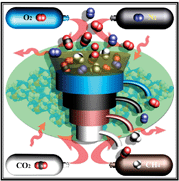Adsorptive separation is very important in industry. Generally, the process uses porous solid materials such as zeolites, activated carbons, or silica gels as adsorbents. With an ever increasing need for a more efficient, energy-saving, and environmentally benign procedure for gas separation, adsorbents with tailored structures and tunable surface properties must be found. Metal–organic frameworks (MOFs), constructed by metal-containing nodes connected by organic bridges, are such a new type of porous materials. They are promising candidates as adsorbents for gas separations due to their large surface areas, adjustable pore sizes and controllable properties, as well as acceptable thermal stability. This critical review starts with a brief introduction to gas separation and purification based on selective adsorption, followed by a review of gas selective adsorption in rigid and flexible MOFs. Based on possible mechanisms, selective adsorptions observed in MOFs are classified, and primary relationships between adsorption properties and framework features are analyzed. As a specific example of tailor-made MOFs, mesh-adjustable molecular sieves are emphasized and the underlying working mechanism elucidated. In addition to the experimental aspect, theoretical investigations from adsorption equilibrium to diffusion dynamics via molecular simulations are also briefly reviewed. Furthermore, gas separations in MOFs, including the molecular sieving effect, kinetic separation, the quantum sieving effect for H2/D2 separation, and MOF-based membranes are also summarized (227 references).


 Please wait while we load your content...
Please wait while we load your content...